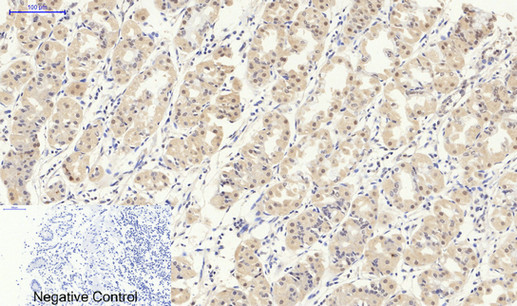
Catalog: YT4332
Size
Price
Status
Qty.
200μL
$450.00
In stock
0
100μL
$280.00
In stock
0
40μL
$150.00
In stock
0
Add to cart


Collected


Collect
Main Information
Target
Smad2/3
Host Species
Rabbit
Reactivity
Human, Mouse, Rat, Monkey, Pig
Applications
WB, IHC, IF, ELISA
MW
48kD (Observed)
Conjugate/Modification
Unmodified
Detailed Information
Recommended Dilution Ratio
WB 1:500-1:2000; IHC 1:100-1:300; ELISA 1:10000; IF 1:50-200
Formulation
Liquid in PBS containing 50% glycerol, 0.5% BSA and 0.02% sodium azide.
Specificity
Smad2/3 Polyclonal Antibody detects endogenous levels of Smad2/3 protein.
Purification
The antibody was affinity-purified from rabbit antiserum by affinity-chromatography using epitope-specific immunogen.
Storage
-15°C to -25°C/1 year(Do not lower than -25°C)
Concentration
1 mg/ml
MW(Observed)
48kD
Modification
Unmodified
Clonality
Polyclonal
Isotype
IgG
Related Products
Antigen&Target Information
Immunogen:
The antiserum was produced against synthesized peptide derived from human Smad2/3. AA range:1-50
show all
Specificity:
Smad2/3 Polyclonal Antibody detects endogenous levels of Smad2/3 protein.
show all
Gene Name:
SMAD2/SMAD3
show all
Protein Name:
Mothers against decapentaplegic homolog 2/3
show all
Other Name:
SMAD2 ;
MADH2 ;
MADR2 ;
Mothers against decapentaplegic homolog 2 ;
MAD homolog 2 ;
Mothers against DPP homolog 2 ;
JV18-1 ;
Mad-related protein 2 ;
hMAD-2 ;
SMAD family member 2 ;
SMAD 2 ;
Smad2 ;
hSMAD2 ;
SMAD3 ;
MADH3 ;
Mothers against decapentaplegic
MADH2 ;
MADR2 ;
Mothers against decapentaplegic homolog 2 ;
MAD homolog 2 ;
Mothers against DPP homolog 2 ;
JV18-1 ;
Mad-related protein 2 ;
hMAD-2 ;
SMAD family member 2 ;
SMAD 2 ;
Smad2 ;
hSMAD2 ;
SMAD3 ;
MADH3 ;
Mothers against decapentaplegic
show all
Database Link:
Background:
The protein encoded by this gene belongs to the SMAD, a family of proteins similar to the gene products of the Drosophila gene 'mothers against decapentaplegic' (Mad) and the C. elegans gene Sma. SMAD proteins are signal transducers and transcriptional modulators that mediate multiple signaling pathways. This protein mediates the signal of the transforming growth factor (TGF)-beta, and thus regulates multiple cellular processes, such as cell proliferation, apoptosis, and differentiation. This protein is recruited to the TGF-beta receptors through its interaction with the SMAD anchor for receptor activation (SARA) protein. In response to TGF-beta signal, this protein is phosphorylated by the TGF-beta receptors. The phosphorylation induces the dissociation of this protein with SARA and the association with the family member SMAD4. The association with SMAD4 is important for the translocation
show all
Function:
Disease:Defects in SMAD2 are found in sporadic cases of colorectal carcinoma.,Function:Transcriptional modulator activated by TGF-beta and activin type 1 receptor kinase. SMAD2 is a receptor-regulated SMAD (R-SMAD). May act as a tumor suppressor in colorectal carcinoma.,PTM:Acetylated on Lys-19 by coactivators in response to TGF-beta signaling, which increases transcriptional activity. Isoform short: Acetylation increases DNA binding activity in vitro and enhances its association with target promoters in vivo.,PTM:In response to TGF-beta, ubiquitinated by NEDD4L; which promotes its degradation.,PTM:Phosphorylated on one or several of Thr-220, Ser-245, Ser-250, and Ser-255. In response to TGF-beta, phosphorylated on Ser-465/467 by TGF-beta and activin type 1 receptor kinases. Able to interact with SMURF2 when phosphorylated on Ser-465/467, recruiting other proteins, such as SNON, for degradation. In response to decorin, the naturally occurring inhibitor of TGF-beta signaling, phosphorylated on Ser-240 by CaMK2. Phosphorylated by MAPK3 upon EGF stimulation; which increases transcriptional activity and stability, and is blocked by calmodulin.,similarity:Belongs to the dwarfin/SMAD family.,similarity:Contains 1 MH1 (MAD homology 1) domain.,similarity:Contains 1 MH2 (MAD homology 2) domain.,subcellular location:Cytoplasmic in the absence of ligand. Migrates to the nucleus when complexed with SMAD4.,subunit:Found in a complex with SMAD3 and TRIM33 upon addition of TGF-beta. Interacts with SMAD3 and TRIM33. Interacts with SARA (SMAD anchor for receptor activation); may form trimers with the SMAD4 co-SMAD. Interacts with FOXH1, homeobox protein TGIF, PEBP2-alpha subunit, CREB-binding protein (CBP), EP300 and SKI. Interacts with SNON; when phosphorylated at Ser-465/467. Interacts (via PY-motif) with SMURF2. Interacts with AIP1 and HGS. Interacts with NEDD4L in response to TGF-beta (By similarity). Interacts with LBXCOR1 and CORL2.,tissue specificity:Expressed at high levels in skeletal muscle, heart and placenta.,
show all
Cellular Localization:
Cytoplasm . Nucleus . Cytoplasmic and nuclear in the absence of TGF-beta. On TGF-beta stimulation, migrates to the nucleus when complexed with SMAD4 (PubMed:9865696, PubMed:21145499). On dephosphorylation by phosphatase PPM1A, released from the SMAD2/SMAD4 complex, and exported out of the nucleus by interaction with RANBP1 (PubMed:16751101, PubMed:19289081). Localized mainly to the nucleus in the early stages of embryo development with expression becoming evident in the cytoplasm at the blastocyst and epiblast stages (By similarity). .
show all
Tissue Expression:
Expressed at high levels in skeletal muscle, endothelial cells, heart and placenta.
show all
Research Areas:
>>Cell cycle ;
>>Endocytosis ;
>>Cellular senescence ;
>>TGF-beta signaling pathway ;
>>Apelin signaling pathway ;
>>Hippo signaling pathway ;
>>Signaling pathways regulating pluripotency of stem cells ;
>>Th17 cell differentiation ;
>>Relaxin signaling pathway ;
>>AGE-RAGE signaling pathway in diabetic complications ;
>>Chagas disease ;
>>Human T-cell leukemia virus 1 infection ;
>>Pathways in cancer ;
>>Proteoglycans in cancer ;
>>Colorectal cancer ;
>>Pancreatic cancer ;
>>Hepatocellular carcinoma ;
>>Gastric cancer ;
>>Inflammatory bowel disease ;
>>Diabetic cardiomyopathy
>>Endocytosis ;
>>Cellular senescence ;
>>TGF-beta signaling pathway ;
>>Apelin signaling pathway ;
>>Hippo signaling pathway ;
>>Signaling pathways regulating pluripotency of stem cells ;
>>Th17 cell differentiation ;
>>Relaxin signaling pathway ;
>>AGE-RAGE signaling pathway in diabetic complications ;
>>Chagas disease ;
>>Human T-cell leukemia virus 1 infection ;
>>Pathways in cancer ;
>>Proteoglycans in cancer ;
>>Colorectal cancer ;
>>Pancreatic cancer ;
>>Hepatocellular carcinoma ;
>>Gastric cancer ;
>>Inflammatory bowel disease ;
>>Diabetic cardiomyopathy
show all
Signaling Pathway
Cellular Processes >> Cell growth and death >> Cell cycle
Cellular Processes >> Cell growth and death >> Cellular senescence
Cellular Processes >> Cellular community - eukaryotes >> Adherens junction
Cellular Processes >> Cellular community - eukaryotes >> Signaling pathways regulating pluripotency of stem cells
Organismal Systems >> Immune system >> Th17 cell differentiation
Organismal Systems >> Endocrine system >> Relaxin signaling pathway
Human Diseases >> Cancer: overview >> Pathways in cancer
Human Diseases >> Cancer: specific types >> Colorectal cancer
Human Diseases >> Cancer: specific types >> Pancreatic cancer
Human Diseases >> Cancer: specific types >> Hepatocellular carcinoma
Human Diseases >> Cancer: specific types >> Gastric cancer
Human Diseases >> Cancer: specific types >> Chronic myeloid leukemia
Human Diseases >> Immune disease >> Inflammatory bowel disease
Environmental Information Processing >> Signal transduction >> Wnt signaling pathway
Environmental Information Processing >> Signal transduction >> TGF-beta signaling pathway
Environmental Information Processing >> Signal transduction >> Hippo signaling pathway
Environmental Information Processing >> Signal transduction >> Apelin signaling pathway
Environmental Information Processing >> Signal transduction >> FoxO signaling pathway
Reference Citation({{totalcount}})
Catalog: YT4332
Size
Price
Status
Qty.
200μL
$450.00
In stock
0
100μL
$280.00
In stock
0
40μL
$150.00
In stock
0
Add to cart


Collected


Collect
Recently Viewed Products
Clear allPRODUCTS
CUSTOMIZED
ABOUT US
Toggle night Mode
{{pinfoXq.title || ''}}
Catalog: {{pinfoXq.catalog || ''}}
Filter:
All
{{item.name}}
{{pinfo.title}}
-{{pinfo.catalog}}
Main Information
Target
{{pinfo.target}}
Reactivity
{{pinfo.react}}
Applications
{{pinfo.applicat}}
Conjugate/Modification
{{pinfo.coupling}}/{{pinfo.modific}}
MW (kDa)
{{pinfo.mwcalc}}
Host Species
{{pinfo.hostspec}}
Isotype
{{pinfo.isotype}}
Product {{index}}/{{pcount}}
Prev
Next
{{pvTitle}}
Scroll wheel zooms the picture
{{pvDescr}}






















